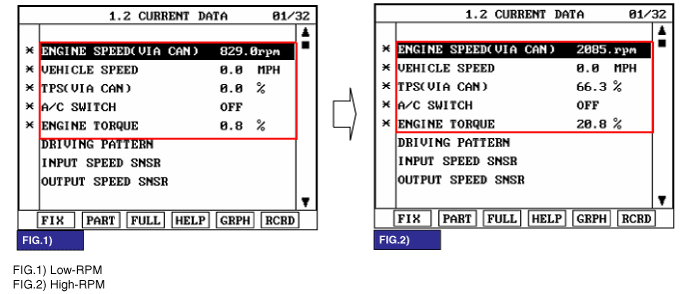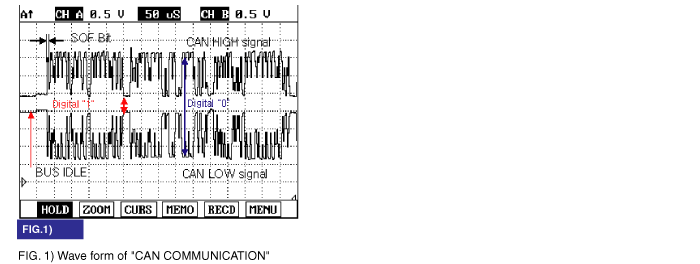Monitor the "CAN COMMUNICATION SERVICE DATA (ENGINE RPM, VEHICLE SPEED SENSOR, THROTTLE P. SENSOR)" parameters on the scantool.


The TCM can either receive data from the Engine Control Module or ABS control module, or it can send data to the ECM and ABSCM by using CAN communication. The CAN communicaton is one of the vehicle communication methods, which is now widely used to transfer the vehicle data.
The TCM reads data on the CAN-BUS line and checks whether the data is equal to the data which the TCM sent before. If the data is not the same the TCM decides that either the CAN-BUS line or TCM are malfuncting and sets this code.
Item | Detecting Condition | Possible cause |
DTC Strategy | ● Check communication | ● Open or short in CAN communication harness ● Faulty ECM ● Faulty TCM |
Enable Conditions | ● Input Speed >300rpm | |
Threshold value | ● No message from ems | |
Diagnostic Time | ● More than 2.5sec | |
Fail Safe | ● INTELLIGENT SHIFT is inhibited ● Learning for oil pressure control is inhibited ● Torque Retard requirement is inhibited ● Direct connection control of DCC is inhibited |

Connect scantool to data link connector(DLC).
Engine "ON".
Monitor the "CAN COMMUNICATION SERVICE DATA (ENGINE RPM, VEHICLE SPEED SENSOR, THROTTLE P. SENSOR)" parameters on the scantool.

Does "CAN BUS LINE DATA" follow the reference data?

▶ Fault is intermittent caused by poor contact in the sensor's and/or TCM(PCM)'s connector or was repaired and TCM(PCM) memory was not cleared. Thoroughly check connectors for looseness, poor connection, bending, corrosion, contamination, deterioration or damage. Repair or replace as necessary and go to "Verification of Vehicle Repair" procedure.

▶ Go to "Terminal & connector inspection" procedure.
Many malfunctions in the electrical system are caused by poor harness and terminals. Faults can also be caused by interference from other electrical systems, and mechanical or chemical damage.
Thoroughly check connectors for looseness, poor connection, bending, corrosion, contamination, deterioration, or damage.
Has a problem been found?

▶ Repair as necessary and go to "Verification of vehicle repair" procedure.

▶ Go to "Signal circuit inspection" procedure.
Ignition "ON"&Engine "OFF".
Disconnect the "PCM/TCM" connector.
Measure resistance between terminal "12" and "27" of the "PCM/TCM" harness connector.
Specification : Approx. 120Ω

Is measured resistance within specifications?

▶ Substitute with a known-good PCM/TCM and check for proper operation. If the problem is corrected, replace PCM/TCM as necessary and then go to "Verification of Vehicle Repair" procedure.

▶ Check connectors for looseness, poor connection, bending, corrosion, contamination, deterioration or damage of ECM.and then Repair or replace Resistance for CAN communication as necessary and go to "Verification of Vehicle Repair" procedure.
After a repair, it is essential to verify that the fault has been corrected.
Connect scantool and select "Diagnostic Trouble Codes(DTCs)" mode.
Using a scantool, Clear DTC.
Operate the vehicle within DTC Enable conditions in General information.
Are any DTCs present?

▶ Go to the applicable troubleshooting procedure.

▶ System performing to specification at this time.